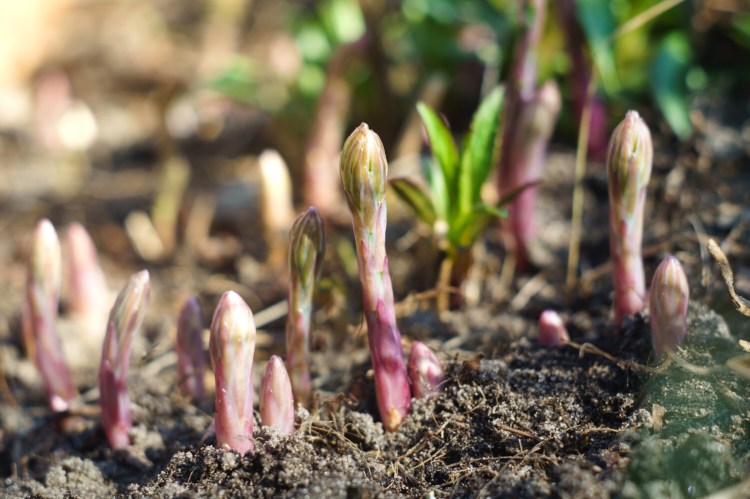Better late than never, people say. And it is true.
This has been a late year for everything we grow in our gardens. The crops have been bountiful, in some cases the best we have ever had, but everything has come in at least a week later than usual – and in the case of shelling peas, almost three weeks later.
This was caused by a late, wet spring – which I wrote about in June. Temperatures, especially the daytime highs, were way below normal and rainfall well above normal all through June. That not only slowed the development of perennial crops, like asparagus and strawberries, but kept people from planting cool-season vegetables such as peas, lettuce and carrots.
Some traditions fell by the wayside – or had to be adjusted.
We had asparagus for my May 15 birthday, but the amount wasn’t even a typical serving for my wife, Nancy, and me.
Strawberries were scarce for the strawberry festivals in Cape Elizabeth, which are often held the fourth weekend in June. Nancy and I had 10 strawberries that we cut up and put on top of waffles for the Sunday breakfast on June 23.
Another tradition is peas and salmon for the Fourth of July. The Amish edible-pod peas that I got from Fedco as an experiment were in full production, so we ate those as appetizers. But the shelling peas and Sugar Snaps weren’t ready. Instead, we bought our shelling peas from a local farm stand. Peas on the Fourth are important.
I will say that once things started producing, they were bountiful.
We ate asparagus every day from May 18 through June 22, and we gave away about 5 pounds to friends and neighbors. I picked 55 quarts of strawberries. (That is filled, level, as I brought them in from the garden. After Nancy threw out the insect-damaged ones and mounded them up so they looked good, the number decreased.) We ate strawberries every day from June 26 to July 18; Nancy made four batches of jam and we gave away 12 quarts.
We’ve also had lettuce daily since early May. We had our first meal of summer squash/zucchini July 8 and the plants are continuing to produce regularly. Two plantings of carrots are doing well, but I’ve harvested only a few to eat raw to prove they were available if we wanted them instead of asparagus, first, and then peas and summer squash.
On July 16 we picked our first ripe tomato (Sun Gold). It came from the group of plants I’d put in under a miniature greenhouse. Tomato and pepper production seems to be coming along well, but the tomato I picked came from the row I planted in mid-May under a small hoop house, so planting early with protection does provide an earlier crop. The peppers and tomatoes I planted Memorial Day weekend without protection look good, too, and should be bearing ripe produce by the time this column appears in print.
As for the flowers we plant in the vegetable garden, I cut the first dahlias July 16. More dahlias and a lot of gladioli will be coming soon.
I wrote earlier about how the cool spring made the blooms of flowering shrubs and perennials last longer; that has continued through midsummer. Everything seems to have bloomed well this year, with the blossoms lasting a long time.
One goal I mentioned in my season-opening column in April was that I wanted our backyard flower garden to have more blossoms late in the season. The rhododendrons and azaleas brighten up the early season, but in July and August last year the yard was a sea of green.
To solve that problem, we added two shrubs.
A hydrangea arborescens “Haas Halo” has bloomed beautifully its first year, and is perfect for our mostly shady yard. It has lace-cap blossoms that the catalog said would be 12 to 14 inches in diameter. Ours are only 7 inches, but they are striking, and probably will get larger as the plant matures. We like that it is lace-cap, because it is friendlier to pollinators than the most popular hydrangea arborescens, “Annabelle,” which has double flowers.

Some day, Tom Atwell’s bottlebrush buckeye will have blooms like this. But not yet. Carmen Hauser/Shutterstock
Our bottlebrush buckeye (Aesculus parviflora) isn’t going to blossom this year, although the foliage is large and striking.
And my attempt to improve the back lawn was only semisuccessful. We do have a higher percentage of grass than we had before, but the violets still dominate. And Nancy says some of the grass seed got caught between the bricks that line the back gardens, so she had to do a lot more weeding. So, I’ll call that experiment a failure.
We’ve been doing more garden maintenance than normal, getting ready for the family reunion we are hosting Aug. 3. Everything looks good, but it’s not perfect. That means I should stop writing and and get back to weeding.
TOM ATWELL is a freelance writer gardening in Cape Elizabeth. He can be contacted at: tomatwell@me.com
Send questions/comments to the editors.


